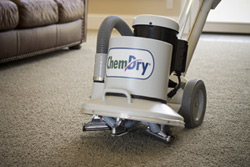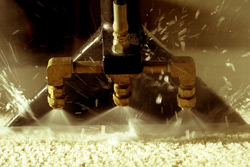Chem-Dry vs. Steam Cleaning

One of the most common questions we receive here at Chem-Dry is ‘what is the difference between Chem-Dry’s cleaning process and steam cleaning’. There are several differences that explain why Chem-Dry’s hot carbonated cleaning system offers a deeper, faster drying and healthier carpet cleaning experience than steam cleaners.
Typical steam cleaning services spray an excessive amount of water filled with soaps and detergents into your carpets, leaving them wet for several days. This process can create an unhealthy breeding ground for mold, mildew and bacteria. Also, a sticky residue is left behind from the soaps causing your carpets to attract dirt much faster.
Here at Chem-Dry our cleaning process is more advanced. Our carbonated cleaning solution employs millions of microscopic bubbles into your carpet fibers that literally explode the dirt off. By using this cleaning solution Chem-Dry is able to use only 30% of the amount of water that a typical steam cleaner uses. After the carbonation (bubbles) lifts the dirt to the surface of your carpets, our cleaning equipment extracts the dirt and moisture from your carpet.
The result of our cleaning process is a deeper, healthier clean that dries in only 1-3 hours. No dirt attracting residue is left behind, so your carpets stay drier, longer.
Let’s Compare, which would you choose?

Chem-Dry Hot Carbonated Cleaning Process
- Carbonated, active cleaning solution
- No soaps, detergents or phosphates
- No sticky residue, resists re-soiling
- Low moisture cleaning
- Low pressure application
- Short dry time, 1-3 hours
- Green certified solutions, healthy cleaning method

Traditional Steam Cleaning Process
- Inactive cleaning solution
- Harsh chemicals, soaps and detergents
- Dirt attracting residue left behind
- Gallons of soapy water
- High pressure application
- Long dry time, 1-3 days
- Excessive water usage can cause mold, mildew & bacteria growth
Learn more about our services
Cleaning Upholstery
Cleaning Area Rug
Cleaning Pet Stain
Removal Specialty Stain
Cleaning Tile & Stone
Cleaning Leather
Cleaning Commercial
Services
